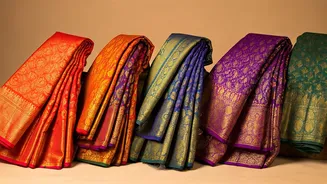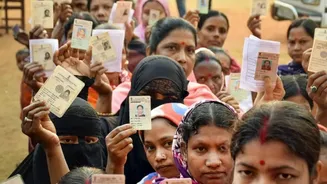Saree: An Introduction
The saree, a garment synonymous with Indian identity, is much more than mere fabric; it embodies tradition, artistry, and cultural heritage. Worn by women
across the Indian subcontinent, the saree consists of an unstitched length of cloth, typically ranging from 4.5 to 9 meters in length, draped over the body in various styles. Its versatility allows for diverse expressions of personal style and regional identity. Each fold, each pleat, and each embellishment tells a story, making the saree a canvas of culture. The evolution of the saree mirrors the changing times, adapting to contemporary fashion while retaining its core essence. This iconic garment stands as a testament to the rich textile traditions of India, showcasing a legacy of craftsmanship passed down through generations. From the intricate weaves of Banaras to the vibrant prints of Gujarat, the saree encapsulates the spirit of India.
Diverse Types of Sarees
India's saree landscape is incredibly diverse, reflecting the rich tapestry of regional cultures and weaving techniques. Each region boasts its unique style, fabric, and design. Silk sarees, revered for their luxurious feel and elaborate patterns, are particularly popular. The Kanjeevaram silk sarees from Tamil Nadu are celebrated for their vibrant colors and heavy borders, often featuring traditional motifs like temples, animals, and flowers. Banarasi silk sarees from Uttar Pradesh are known for their intricate brocade work, typically using gold and silver threads. Cotton sarees, on the other hand, provide comfort and breathability, making them suitable for everyday wear, particularly in warmer climates. Handloom cotton sarees from states like West Bengal and Odisha feature striking designs and comfortable textures. Other notable saree types include the Patola from Gujarat with its geometric patterns, the Chanderi from Madhya Pradesh known for its sheer texture, and the Bandhani from Rajasthan, created through the tie-and-dye technique. Each saree type tells a unique story, offering glimpses into the diverse artistic and cultural heritage of India.
Regional Variations Galore
The beauty of sarees lies in their regional variations, each reflecting the specific cultural nuances of the area. Each state has distinct styles, designs, and draping methods. In Maharashtra, the traditional Nauvari saree is draped in a unique way, allowing for freedom of movement, and is often paired with a nose pin and traditional jewelry. Bengal showcases the elegant handloom sarees with floral and geometric designs, particularly the Tant sarees. The South Indian states offer a wealth of saree varieties, including the Kanjeevaram, Mysore silk, and Dharmavaram sarees. In Gujarat, the Patola sarees, with their complex designs, are prized possessions, woven with great skill and artistry. Similarly, the vibrant Bandhani sarees of Rajasthan showcase the intricate tie-and-dye techniques. Each of these regional styles reveals the unique identity and artistic skills passed down through generations. The diverse draping styles—from the traditional Nivi style to more modern adaptations—further enhance the unique charm and appeal of the saree.
Saree's Historical Significance
The saree has a deep-rooted history, its origins tracing back thousands of years. Early evidence suggests the saree evolved from simple garments used in ancient times. Over centuries, the saree has evolved, influenced by various empires, rulers, and cultural exchanges. During the Mughal era, for instance, the introduction of intricate weaving techniques, such as brocade, enriched the saree's design. The British colonial period impacted saree design and production, leading to the rise of mills and new textile innovations. The saree has always been a symbol of womanhood, elegance, and grace. Throughout history, it has transcended its functional purpose, becoming a marker of social status, marital status, and cultural identity. Historical accounts and ancient art forms vividly display the saree's evolving role, demonstrating its enduring presence in the lives of women in India.
Saree in Modern Fashion
The saree continues to evolve with the times, maintaining its timeless appeal. Contemporary designers have embraced the saree, experimenting with new fabrics, designs, and draping styles, giving it a modern twist. The saree is frequently seen on runways, red carpets, and in popular culture, proving its versatility. Modern sarees are available in a variety of materials, including georgette, chiffon, and even synthetic fabrics, to fit different preferences and occasions. The blouse, an essential part of the saree ensemble, has also undergone significant transformation. Contemporary designs blend traditional craftsmanship with modern silhouettes. Young women are also seen embracing the saree, mixing traditional sarees with contemporary blouses and accessories to create fresh looks. This seamless blend of tradition and modernity guarantees that the saree will endure for generations to come, adapting to changing fashion trends while honoring its fundamental values.
















